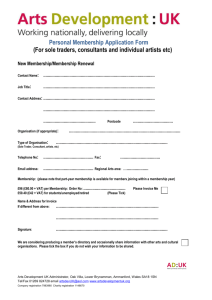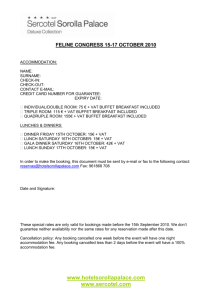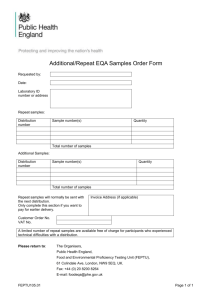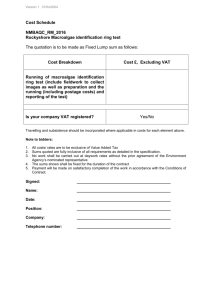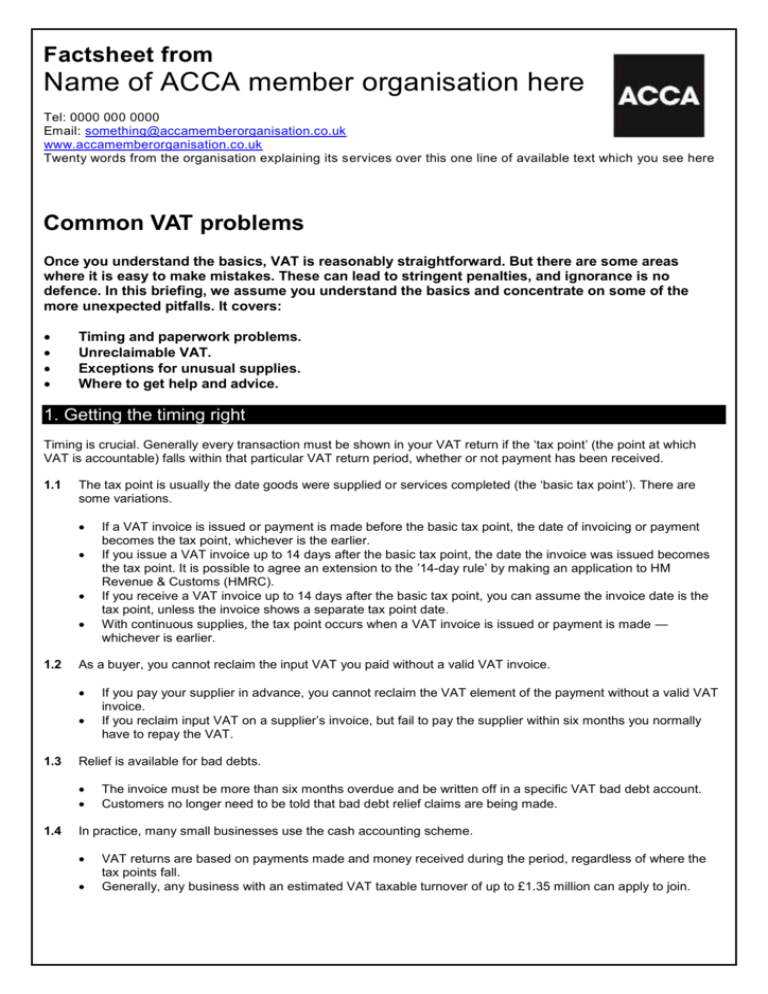
Factsheet from
Name of ACCA member organisation here
Tel: 0000 000 0000
Email: something@accamemberorganisation.co.uk
www.accamemberorganisation.co.uk
Twenty words from the organisation explaining its services over this one line of available text which you see here
Common VAT problems
Once you understand the basics, VAT is reasonably straightforward. But there are some areas
where it is easy to make mistakes. These can lead to stringent penalties, and ignorance is no
defence. In this briefing, we assume you understand the basics and concentrate on some of the
more unexpected pitfalls. It covers:
Timing and paperwork problems.
Unreclaimable VAT.
Exceptions for unusual supplies.
Where to get help and advice.
1. Getting the timing right
Timing is crucial. Generally every transaction must be shown in your VAT return if the ‘tax point’ (the point at which
VAT is accountable) falls within that particular VAT return period, whether or not payment has been received.
1.1
The tax point is usually the date goods were supplied or services completed (the ‘basic tax point’). There are
some variations.
1.2
As a buyer, you cannot reclaim the input VAT you paid without a valid VAT invoice.
1.3
If you pay your supplier in advance, you cannot reclaim the VAT element of the payment without a valid VAT
invoice.
If you reclaim input VAT on a supplier’s invoice, but fail to pay the supplier within six months you normally
have to repay the VAT.
Relief is available for bad debts.
1.4
If a VAT invoice is issued or payment is made before the basic tax point, the date of invoicing or payment
becomes the tax point, whichever is the earlier.
If you issue a VAT invoice up to 14 days after the basic tax point, the date the invoice was issued becomes
the tax point. It is possible to agree an extension to the ’14-day rule’ by making an application to HM
Revenue & Customs (HMRC).
If you receive a VAT invoice up to 14 days after the basic tax point, you can assume the invoice date is the
tax point, unless the invoice shows a separate tax point date.
With continuous supplies, the tax point occurs when a VAT invoice is issued or payment is made —
whichever is earlier.
The invoice must be more than six months overdue and be written off in a specific VAT bad debt account.
Customers no longer need to be told that bad debt relief claims are being made.
In practice, many small businesses use the cash accounting scheme.
VAT returns are based on payments made and money received during the period, regardless of where the
tax points fall.
Generally, any business with an estimated VAT taxable turnover of up to £1.35 million can apply to join.
1.5
The flat-rate scheme allows small firms to calculate the net VAT they owe by applying a flat-rate percentage to
their turnover.
1.6
The flat-rate percentage depends on your trading sector, so if your net VAT payments are generally a low
percentage of turnover this scheme may not be of benefit.
Tax invoices must still be issued, but will not be used to calculate the VAT payable.
To join the scheme, estimated VATable turnover (excluding VAT) must be no more than £150,000.
With the annual accounting scheme only one VAT return is submitted each year. Nine monthly interim VAT
payments are made based on an estimate of the total annual VAT bill. A balancing payment is made when the
annual return is submitted.
Any business under the threshold of £1.35 million can apply to use the scheme from the date of VAT
registration.
The leaving threshold is £1.6 million.
2. Getting the paperwork right
2.1
Proper VAT invoices must be issued for supplies to VAT-registered businesses.
2.2
If you make retail sales under £250 (including VAT), you can issue customers with a ‘less detailed’ VAT invoice.
2.3
Input VAT can only be reclaimed by the recipient of the supply.
Consider settling the net value only. It may be worthwhile for the third party to pay the VAT portion of the
invoice and then reclaim it in their own right.
Watch out for arithmetical errors.
2.6
If you lose a VAT invoice, you must get a duplicate invoice from your supplier.
If an invoice shows product codes rather than descriptions, you must also keep a copy of the supplier’s
product list.
If you settle an invoice on behalf of a third party, you cannot reclaim the VAT charge.
2.5
This must show your name; address; VAT number; the date of supply; a description of the supplies; the
amount (including VAT) and the VAT rate charged.
To reclaim the input VAT paid to suppliers, VAT invoices must be retained.
2.4
A full VAT invoice should include a unique identifying number; the supplier’s name, address and VAT
number; the customer’s name and address; the invoice date; the tax point (if this is different from the invoice
date); the type of supply (such as sale or rent); a description of and the amount of goods or services
supplied; unit price; any cash discount rate; the VAT rate; the total excluding VAT; the VAT amount and the
total payable.
VAT invoice numbers must be sequential, with no unexplained gaps.
Duplicate invoices must be clearly marked.
If you issue other documents (eg pro-forma invoices), which show the same details, they must clearly state
‘Not a VAT invoice’.
If you are given an invoice which does not show VAT as a separate item, confirm the items are VATable and
check what you can reclaim by multiplying the amount on the invoice by 1/6, not by 20%.
If you sell your business, the buyer can apply to retain your VAT registration number. However, this would make
the buyer liable for any past tax overdue, so they may prefer to set up a new VAT registration.
Unless the buyer is retaining your VAT number, you must retain their VAT records. In this case, the buyer
must be given full information so they can comply with their VAT duties.
2
3. Discounts and part exchange
3.1
Discounts can be problematic. The VAT payable on a supply depends on how the discount is offered.
3.2
If an unconditional discount (such as a trade discount) is given, the VAT is based on the discounted value of
the full sale.
The same applies for prompt payment discounts — even if the customer does not pay promptly.
VAT is calculated on the full value of any part-exchange or barter transactions.
VAT must be calculated as if the transaction had been entirely for cash (ie purchases and sales at the full
price). VAT invoices must be issued accordingly.
4. Irreclaimable tax
4.1
Input VAT cannot be reclaimed on supplies for personal (non-business) use.
4.2
If goods or services are bought for both business and non-business use, the input VAT may be apportioned
with only the business element recovered, subject to the normal rules. Or, recovered in full on the entire
purchase of goods provided output VAT is declared on a self-supply of the non-business element.
Input VAT can be reclaimed on some of the supplies made to employees including on:
The actual costs of employees’ subsistence when travelling on business (excluding any flat-rate expenses).
Any free meals that may be provided.
VAT can also be reclaimed on the cost of business mileage paid to employees using their own vehicles. See
VAT Notice 700/64 for the calculation that must be used.
Generally VAT cannot be reclaimed on any free accommodation that is provided. However, if employees have to
be given domestic accommodation wholly for a business purpose HMRC may agree to VAT claims being made.
4.3
There are strict rules applied to sole traders, partners or directors.
4.4
The treatment of entertainment varies, according to who is being entertained.
4.5
They cannot reclaim VAT on free meals at work, but subject to normal rules can claim for subsistence
expenses while on business trips.
VAT on business entertainment for third parties can never be reclaimed.
Reclaims may be allowed for VAT related to staff entertainment. The entertainment must have a discernible
business purpose.
Where the entertainment is for both employees and outsiders, it may be possible to reclaim some VAT.
Generally, a business cannot reclaim VAT on supplies purchased in order to make exempt sales.
Small amounts may be reclaimed if within certain set limits. The calculation of recoverable VAT in this
instance is complex. Get expert advice.
5. Overseas VAT issues
5.1
Imports of goods from another EU country (‘acquisitions’) will generally be free of any VAT charge.
The supplier must show the customer’s UK VAT number on their sales invoice.
UK output VAT must be self-charged and declared in Box 2 of the relevant VAT return covering the date of
the supply (known as acquisition tax). However, as long as the purchase is used to make VATable supplies
the Box 2 VAT can be reclaimed as input VAT in the same return.
3
5.2
Imports of goods from outside the EU attract import VAT, at UK rates, which is payable on entry. Subject to the
normal rules this can be reclaimed as input VAT. The import may also attract customs duty which is also
collected by HMRC.
5.3
Exports of goods to VAT-registered buyers in other EU countries (‘dispatches’) can usually be zero-rated.
5.4
VAT should be added to sales invoices if a customer is not VAT-registered or a valid domestic EU VAT
number is not quoted on the invoice. Such sales could give rise to EU registration requirements if sales
volumes exceed local limits.
Exports of goods to countries outside the EU are zero-rated.
5.5
Customs duty is not recoverable.
To reclaim import VAT, a VAT certificate C79 must be held.
Payment of both import VAT and duty can be deferred which can speed through entry of goods into the UK.
VAT will be due on the sale unless evidence is held that the goods have left the UK within specified time
limits.
Trade with the EU requires extra information to be provided.
Total dispatches and arrivals are required in boxes 8 and 9 of the VAT return.
Details of zero-rated supplies to VAT-registered EU customers must be declared on a separate EC Sales
List.
Additional Intrastat returns are required if the value of arrivals in a calendar year exceeds £600,000 or the
value of dispatches exceeds £250,000.
6. Watch out
VAT must be charged in a number of familiar situations outside the normal run of business.
6.1
Business gifts are usually treated as though they have been sold as VATable supplies, with output VAT due on
the value. There are some exceptions.
There is no output VAT due on individual free samples given to customers.
One-off business gifts costing less than £50 (excluding VAT) do not attract output VAT. The £50 limit applies
to all gifts made to the same person within a 12 month period.
Gifts of services are not normally liable to VAT.
Gifts of goods to charities for sale or export are zero-rated.
6.2
As a general rule, VAT must be charged on all sales to employees.
6.3
If you take items for personal use on which you have accounted for VAT, this counts as a sale (see 4.1).
If you pay nothing, VAT is charged on the cost (normally the market cost).
Special rules apply to cars and fuel.
6.4
The sale of business assets is normally treated in the same way as any other sale.
6.5
The sale of a business as a going concern may be VAT-free. Specific rules apply.
7. Help and advice
7.1
Include VAT records as part of your regular review with your accountant.
7.2
Ask your VAT adviser how your business is affected by VAT rules. It is always advisable to check the VAT
implications of a situation and the options available to you.
4
7.3
If doubts remain, you can safeguard your position by getting a decision in writing from HMRC. Contact the
HMRC National Advice Service (0845 010 9000 or www.hmrc.gov.uk).
HMRC will only be bound by any ruling if all the facts have been disclosed.
Post and packaging
A.
Provided the contract is for ‘delivered goods’, charges are usually taxed at the same rate as the product even if
you show a separate charge on your price list or invoice.
B.
Packaging is normally taxed at the same rate as the contents.
C.
If UK delivery is offered as an optional extra, VAT will be due on the charge.
If the goods are for export, or leave from outside the UK, you should take advice.
If you make a separate charge for packaging, this will always attract VAT.
The treatment of bundled supplies depends on whether there is a mixed or composite supply.
Mixed supplies may contain components liable to different VAT rates.
You work out the total VAT liability in proportion to the value of each component.
Composite supplies have one VAT liability based on the main component.
Tax yes, VAT no
One problem is the gap between what the VAT rules allow a business as expenditure and the rules applied for other
taxes. In general, any expenditure ‘wholly and exclusively for business purposes’ is deductible for direct tax purposes.
Before you can reclaim input VAT, expenditure must be directly attributable to the VATable supplies you are making.
Your supplies might be VATable at the standard, reduced, or zero rates of VAT, or be services that are outside the
scope of the tax but with VAT recovery rights (ie not exempt). If you cannot attribute your expenditure to the VATable
supplies you are making, there will be a VAT cost due.
Note
HMRC are moving to compulsory online filing for VAT from April 2012. All VAT payments will also have to be
made electronically.
Expert contributors
Thanks to Melanie Lord (AVS VAT, 08700 770044).
Last reviewed 01.04.12
© Atom Content Marketing 2012. ISSN 1369-1996. All rights reserved. No part of this publication may be reproduced or transmitted without the
written permission of the publisher. This publication is for general guidance only. The publisher, expert contributors and distributor disclaim all liability
for any errors or omissions. Consult your local business support organisation or your professional adviser for help and advice.
5





